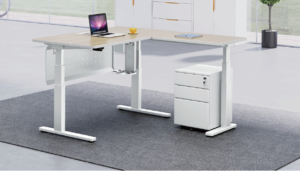The adverse health effects of sedentary behavior, including prolonged sitting at work, are obvious, and most people who sit for extended periods of time have a higher risk of cancer, cardiovascular disease, diabetes and premature death.
Of course, many jobs in the office today require people to work long hours at a fixed station. This is the exact opposite of the pattern in which the human body has been evolved for movement rather than staying in one place for monotonous work. Sitting for a long time, coupled with the influence of bad posture, is harmful to the spine first, and then affects the health of the whole body.
Therefore, it is important to consciously incorporate exercise into your office routine to avoid the harmful effects of being sedentary. In addition to the occasional standing and moving away from your desk, there are also office furniture designs that encourage athletic working.
Elevating desks are now a popular configuration in modern offices. They make the transition from sitting to standing effortless. Changes in body position and posture are essential not only for efficient blood circulation, but also for maintaining a clear mind.
Do you need a height adjustable desk too?
1. Lower back pain
Back pain and pain are common ailments among office workers. Low back pain is akin to stress, both physical and psychological.
Research has shown that employees with chronic back pain benefit greatly from the use of an elevating desk/height adjustable desk. Another study published by the Centers for Disease Control (CDC) showed that height adjustable desks can reduce upper back and neck pain by up to 54% in just four weeks. Of course, vice versa.
2. Improves people’s well-being
In a 7-week study, people who used an elevating desk experienced significantly less stress and fatigue than those who sat and worked every day. Additionally, 87% of those asked to use a standing desk said they felt more energized overall. Instead, when they were asked to go back to their original desk, their mood dropped, back to pre-study levels.
The results of this study confirm the link between a sedentary lifestyle and a higher risk of depression and anxiety. A major concern for those unfamiliar with using height-adjustable desks is that they can negatively impact a person’s ability to perform routine tasks such as typing. However, for those who had successfully moved from full-time seated work to using a height-adjustable desk, there was no discernible effect on their ability to perform the same tasks, including typing speed. Furthermore, since lift desks have a mood-boosting effect on users, it is certain that they increase productivity.
3. Prevent unhealthy weight gain
Sitting all day, no matter how busy your brain and typing fingers are, won’t do your body’s calorie burn any favors. Sitting can burn 60 to 102 calories per hour, while standing only burns about 7 to 10 calories.
Small differences in calorie burn do not seem to be noticeable. However, if you consider how it stacks up over the course of a week, month, or year, the difference adds up.
4. Reduce the risk of cardiovascular disease
The concept emerged as early as 1953 and is nothing new. In a study comparing bus conductors and bus drivers, conductors were found to have half the risk of dying from heart disease as their seated drivers. It was this study that sparked scientific interest in the effects of sitting on cardiovascular health.
It is now believed that prolonged sitting increases a person’s risk of heart disease by 147%. The harmful effects of a sedentary lifestyle are so damaging that not even an hour of vigorous exercise can fully counteract them.
5. They may help lower blood sugar levels
Any increase in blood sugar after a meal is generally detrimental to health. This is especially true if you have type 2 diabetes. However, in one study, office workers who worked standing up for three hours after lunch had a 43 percent lower blood sugar rise compared to those who sat for the same amount of time. Another study showed that standing and sitting every 30 minutes throughout the workday can help reduce blood sugar spikes by around 11%.
At the same time, staying seated after a meal increases the risk of developing type 2 diabetes by as much as 112%.
6. Standing while you work can extend your life
As mentioned earlier, there is a strong link between early death, type 2 diabetes, heart disease, and a sedentary lifestyle. Conversely, more exercise increases a person’s chances of not only losing weight, but improving overall health. In fact, one study showed that simply reducing sitting time to 3 hours a day could increase the average American’s lifespan by two years.
While more research needs to be done to determine the cause-and-effect relationship between more exercise and longer lifespan, past research and available evidence suggest that simply standing more helps improve overall health.
Weiss Office Furniture has a strong space design ability and the ability to give you professional suggestions. Whether you are looking for Height adjustable desks, conference table, office chairs, reception desks or executive office desks, you can find all you need in our store. Visit our website www.iweiss.ca, or our youtube channel https://www.youtube.com/results?search_query=weiss+office+furniture.
Contact us for more information.
